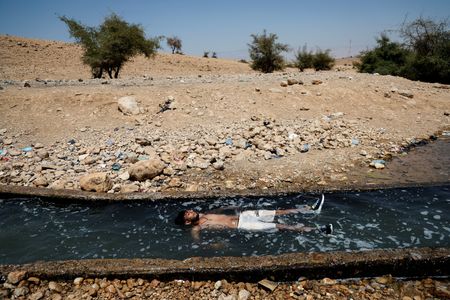By Liliana Salgado
PHOENIX (Reuters) -A global pattern of heat waves scorching parts of Europe, Asia and the United States intensified on Tuesday, with the World Meteorological Organization warning of an increased risk of deaths linked to excessively high temperatures.
Americans were facing a medley of extreme weather, from blazing heat from Texas to Southern California to smoke-choked air wafting into the Midwest from Canada’s wildfires. Flood warnings were up for Vermont towns that were inundated just last week, while Tropical Storm Calvin was expected to hit the Pacific island state of Hawaii later on Tuesday.
The southwestern city of Phoenix, Arizona, on Tuesday recorded its 19th consecutive day in which the daily high exceeded 110 degrees Fahrenheit (43 Celsius), breaking its all-time record of 18 days.
As temperatures in the Arizona capital climbed to 116F (47C), out-of-state visitor Amit Ghagoji, 40, set out for a hike in the trails of Phoenix’s Papago Park.
“It’s like you open an oven door and it’s the heat wave,” Bhagoji said. “If you’re, like, making cookies or something and you open the oven door, it’s going to hit you right in the face.”
Tom Frieders, a meteorologist at the National Weather Service in Phoenix, said regional high temperatures would range between 115F and 120F (48.9C) for five to seven more days if not longer.
“It’ll take probably some monsoon thunderstorms and cooling rains to come – hopefully, eventually – that will help to cool things down,” Frieders said.
In the northeastern state of Vermont, thunderstorms were in the forecast for areas already saturated from recent torrential rainfall, raising the risk of more flooding. Last week, high water in the capital city of Montpelier forced road closures and trapped some residents in their homes.
EUROPE SCORCHED
With baking temperatures hitting Europe during the peak summer tourist season, the World Meteorological Organization (WMO) said the heat wave in the northern hemisphere was set to intensify. An estimated 61,000 people may have died in heat waves last year in Europe alone.
The EU’s emergency response coordination center issued red alerts for high temperatures for most of Italy, northeastern Spain, Croatia, Serbia, southern Bosnia and Herzegovina, and Montenegro.
In Italy, tourists have been trying to keep cool by splashing in Rome’s fountains and standing under giant fans set up outside the Colosseum. Some were forced to queue for taxis for more than an hour in the heat outside the central railway station in Rome due to the capital’s chronic shortage of cabs.
The Mediterranean island of Sardinia hit 44C (112F) and Rome topped out at 40C (104F) on Tuesday, as the health ministry issued red weather alerts for 20 of the country’s 27 main cities, with the number expected to rise to 23 on Wednesday.
The heat has prompted some travelers to go home early. Anita Elshoy and her husband returned to Norway from their vacation spot of Vasanello, a village north of Rome, a week earlier than planned.
“(I) got a lot of pain in the head, legs and (my) fingers swelled up and I became more and more dizzy,” Elshoy said of her heat-related symptoms.
In Greece, authorities told citizens close to a forest fire in Dervenochoria, north of Athens, to shut doors and windows as smoke approached.
Standing in his burned-out house in Ano Lagonissi that had been his home for 32 years, Giorgos Nikolau, 89, described how he fled the fire with just the swimming trunks and shirt he was wearing.
“I have nothing else, I don’t even have other shoes. Nothing. I am finished,” he said.
‘DESPERATE AND URGENT’
The European Union’s Copernicus Climate Change Service says 2022 and 2021 were the continent’s hottest summers on record. Europe’s highest recorded temperature of 48.8C (120F) was registered in Sicily two years ago.
Scientists have long warned that climate change, caused by greenhouse gas emissions mainly from burning fossil fuels, will make heat waves more frequent, severe and deadly. They say governments need to take drastically reduce emissions to prevent climate catastrophe.
Heat waves this summer, which saw temperatures climb to 128F (53C) in California’s Death Valley and over 52C (126F) in China’s northwest, have coincided with wildfires from Greece to the Swiss Alps and deadly flooding in India and South Korea.
They have added renewed urgency to talks this week between the United States and China, the world’s top greenhouse gas polluters.
U.S. climate envoy John Kerry met Chinese officials in Beijing and expressed hope that climate cooperation could redefine troubled ties between the two powers.
Chinese President Xi Jinping stressed Beijing’s commitment to carbon neutrality and a carbon peak was certain but that it would not be influenced by others.
The World Health Organization’s regional director for Europe, Hans Henri P. Kluge, said the world must look ahead while adapting to the “new reality” of killer heat waves and other extreme weather.
“There is a desperate and urgent need for regional and global action to effectively tackle the climate crisis, which poses an existential threat to the human race,” Kluge said.
(Reporting by Liliana Salgado in Phoenix, Angelo Amante and Crispian Balmer in Rome, Giselda Vagnoni in Milan, Gabrielle Tétrault-Farber and Emma Farge in Geneva, Angeliki Koutantou in Athens, Emma Pinedo in Madrid, Julia Harte in New York and Liliana Salgado in Phoenix; Writing by Matthias Williams and Daniel Trotta; Editing by Janet Lawrence, Aurora Ellis and Sandra Maler)











